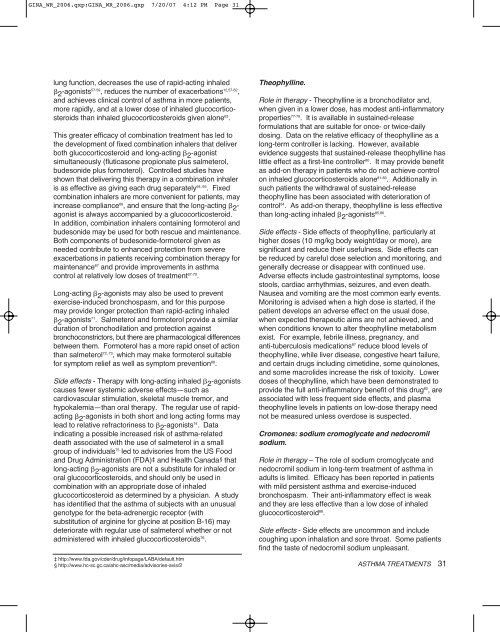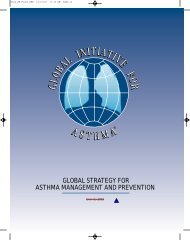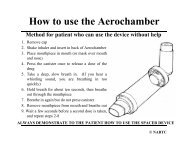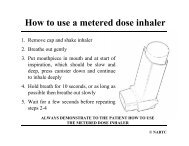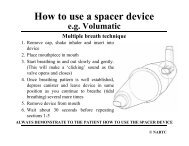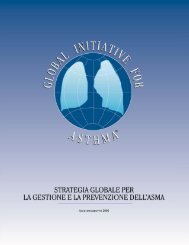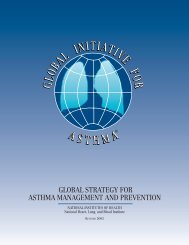global strategy for asthma management and prevention
global strategy for asthma management and prevention
global strategy for asthma management and prevention
You also want an ePaper? Increase the reach of your titles
YUMPU automatically turns print PDFs into web optimized ePapers that Google loves.
GINA_WR_2006.qxp:GINA_WR_2006.qxp 7/20/07 4:12 PM Page 31lung function, decreases the use of rapid-acting inhaled 2 -agonists 57-59 , reduces the number of exacerbations 12,57-62 ,<strong>and</strong> achieves clinical control of <strong>asthma</strong> in more patients,more rapidly, <strong>and</strong> at a lower dose of inhaled glucocorticosteroidsthan inhaled glucocorticosteroids given alone 63 .This greater efficacy of combination treatment has led tothe development of fixed combination inhalers that deliverboth glucocorticosteroid <strong>and</strong> long-acting 2 -agonistsimultaneously (fluticasone propionate plus salmeterol,budesonide plus <strong>for</strong>moterol). Controlled studies haveshown that delivering this therapy in a combination inhaleris as effective as giving each drug separately 64, 65 . Fixedcombination inhalers are more convenient <strong>for</strong> patients, mayincrease compliance 66 , <strong>and</strong> ensure that the long-acting 2 -agonist is always accompanied by a glucocorticosteroid.In addition, combination inhalers containing <strong>for</strong>moterol <strong>and</strong>budesonide may be used <strong>for</strong> both rescue <strong>and</strong> maintenance.Both components of budesonide-<strong>for</strong>moterol given asneeded contribute to enhanced protection from severeexacerbations in patients receiving combination therapy <strong>for</strong>maintenance 67 <strong>and</strong> provide improvements in <strong>asthma</strong>control at relatively low doses of treatment 67-70 .Long-acting 2 -agonists may also be used to preventexercise-induced bronchospasm, <strong>and</strong> <strong>for</strong> this purposemay provide longer protection than rapid-acting inhaled 2 -agonists 71 . Salmeterol <strong>and</strong> <strong>for</strong>moterol provide a similarduration of bronchodilation <strong>and</strong> protection againstbronchoconstrictors, but there are pharmacological differencesbetween them. Formoterol has a more rapid onset of actionthan salmeterol 72, 73 , which may make <strong>for</strong>moterol suitable<strong>for</strong> symptom relief as well as symptom <strong>prevention</strong> 68 .Side effects - Therapy with long-acting inhaled 2 -agonistscauses fewer systemic adverse effects—such ascardiovascular stimulation, skeletal muscle tremor, <strong>and</strong>hypokalemia—than oral therapy. The regular use of rapidacting 2 -agonists in both short <strong>and</strong> long acting <strong>for</strong>ms maylead to relative refractoriness to 2 -agonists 74 . Dataindicating a possible increased risk of <strong>asthma</strong>-relateddeath associated with the use of salmeterol in a smallgroup of individuals 75 led to advisories from the US Food<strong>and</strong> Drug Administration (FDA)‡ <strong>and</strong> Health Canada § thatlong-acting 2 -agonists are not a substitute <strong>for</strong> inhaled ororal glucocorticosteroids, <strong>and</strong> should only be used incombination with an appropriate dose of inhaledglucocorticosteroid as determined by a physician. A studyhas identified that the <strong>asthma</strong> of subjects with an unusualgenotype <strong>for</strong> the beta-adrenergic receptor (withsubstitution of arginine <strong>for</strong> glycine at position B-16) maydeteriorate with regular use of salmeterol whether or notadministered with inhaled glucocorticosteroids 76 .‡ http://www.fda.gov/cder/drug/infopage/LABA/default.htm§ http://www.hc-sc.gc.ca/ahc-asc/media/advisories-avis/2Theophylline.Role in therapy - Theophylline is a bronchodilator <strong>and</strong>,when given in a lower dose, has modest anti-inflammatoryproperties 77-79 . It is available in sustained-release<strong>for</strong>mulations that are suitable <strong>for</strong> once- or twice-dailydosing. Data on the relative efficacy of theophylline as along-term controller is lacking. However, availableevidence suggests that sustained-release theophylline haslittle effect as a first-line controller 80 . It may provide benefitas add-on therapy in patients who do not achieve controlon inhaled glucocorticosteroids alone 81-83 . Additionally insuch patients the withdrawal of sustained-releasetheophylline has been associated with deterioration ofcontrol 84 . As add-on therapy, theophylline is less effectivethan long-acting inhaled 2 -agonists 85,86 .Side effects - Side effects of theophylline, particularly athigher doses (10 mg/kg body weight/day or more), aresignificant <strong>and</strong> reduce their usefulness. Side effects canbe reduced by careful dose selection <strong>and</strong> monitoring, <strong>and</strong>generally decrease or disappear with continued use.Adverse effects include gastrointestinal symptoms, loosestools, cardiac arrhythmias, seizures, <strong>and</strong> even death.Nausea <strong>and</strong> vomiting are the most common early events.Monitoring is advised when a high dose is started, if thepatient develops an adverse effect on the usual dose,when expected therapeutic aims are not achieved, <strong>and</strong>when conditions known to alter theophylline metabolismexist. For example, febrile illness, pregnancy, <strong>and</strong>anti-tuberculosis medications 87 reduce blood levels oftheophylline, while liver disease, congestive heart failure,<strong>and</strong> certain drugs including cimetidine, some quinolones,<strong>and</strong> some macrolides increase the risk of toxicity. Lowerdoses of theophylline, which have been demonstrated toprovide the full anti-inflammatory benefit of this drug 82 , areassociated with less frequent side effects, <strong>and</strong> plasmatheophylline levels in patients on low-dose therapy neednot be measured unless overdose is suspected.Cromones: sodium cromoglycate <strong>and</strong> nedocromilsodium.Role in therapy – The role of sodium cromoglycate <strong>and</strong>nedocromil sodium in long-term treatment of <strong>asthma</strong> inadults is limited. Efficacy has been reported in patientswith mild persistent <strong>asthma</strong> <strong>and</strong> exercise-inducedbronchospasm. Their anti-inflammatory effect is weak<strong>and</strong> they are less effective than a low dose of inhaledglucocorticosteroid 88 .Side effects - Side effects are uncommon <strong>and</strong> includecoughing upon inhalation <strong>and</strong> sore throat. Some patientsfind the taste of nedocromil sodium unpleasant.ASTHMA TREATMENTS 31


